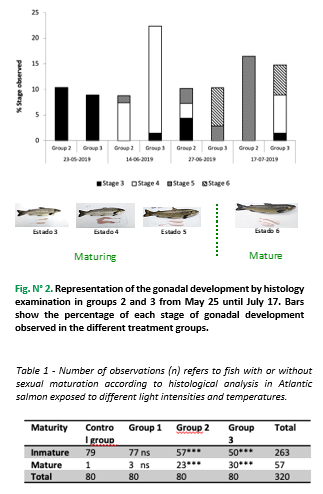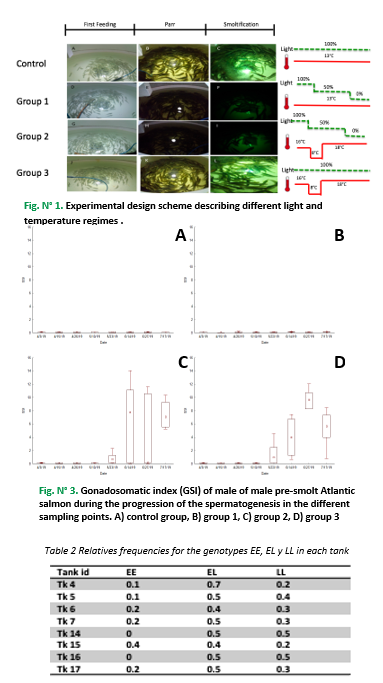CHANGES IN TEMPERATURE OVERRIDES LIGHT INTENSITY EFFECTS AND TRIGGERS EARLY MATURATION IN PRE-SMOLT ATLANTIC SALMON
Introduction:
Timing of maturation in salmon is a highly plastic process. The resultant life cycle depends on an interaction between the genetic makeup of the fish and environmental conditions (Swanson et al., 2011). It’s known, that there are some factors as growth and body fat levels that influence the onset of puberty in critical seasonal periods, however at commercial scale is not so clear how this model work to explain the high rates of mini-jacks observed. According to BioledÒ gonadal ultrasound monitoring, it has been identified a series of freshwater facilities with a high prevalence of minijacks before the seawater transfer
Materials and methods:
The study was carried out in RAS experimental facility ATC Patagonia, in Puerto Montt, Chile. 4 experimental groups were formed, each group in duplicate, with different regimes of light and temperature as described in the scheme of fig 1 (Fig. N°1).
Results:
Only in the group 2 and 3 were observed effect on the entrainment in maturity in different degrees Fig 2.
Conclusions:
This is the first study where the effect of extreme changes in temperature and decrease in light intensity to very low levels are studied in Atlantic salmon. The obtained results indicate that temperature can act as an enabling factor in the early stages of sexual maturation in salmon during 8:16 and 24:0 photoperiod in pre-smolt Atlantic salmon. Light intensity seems to have a minor role as an environmental cue at this stage in the salmon life cycle to trigger maturation and the mechanism involved is still unknown. This may be of particular importance for FW salmon producers in flow through systems in warm regions such as northern salmon producing regions in Chile and Tasmania, also for production in RAS closed-containment where high temperatures are frequently observed.

